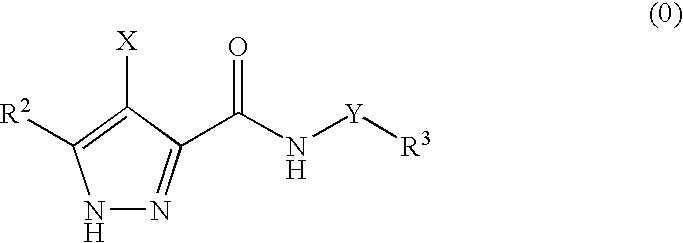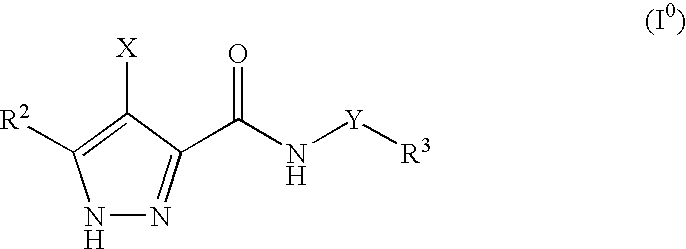Pharmaceutical combinations
a technology of combination and drugs, applied in the field of drug combinations, can solve the problems of cyclin e in solid tumours, poor patient prognosis, cell cycle arrest and/or cell apoptosis, etc., and achieve the effect of reducing the incidence of cancer or reducing the incidence of cancer
- Summary
- Abstract
- Description
- Claims
- Application Information
AI Technical Summary
Benefits of technology
Problems solved by technology
Method used
Image
Examples
example 1
General Procedure A: Preparation of Amide from Amino-Pyrazole
[0757]
[0758]To a stirred solution of the appropriate 4-amino-1H-pyrazole-3-carboxylic acid amide (0.23 mmol), EDAC (52 mg; 0.27 mmol) and HOBt (37 mg; 0.27 mmol) in 5 ml of N,N-dimethylformamide was added the corresponding carboxylic acid (0.25 mmol), and the mixture was then left at room temperature overnight. The reaction mixture was evaporated and the residue purified by preparative LC / MS, to give the product.
General Procedure B: Deprotection of Piperidine Ring Nitrogen by Removal of tert-Butoxycarbonyl Group
[0759]A product of Procedure B containing a piperidine group bearing an N-tert-butoxycarbonyl (t-Boc) protecting group (40 mg) was treated with saturated ethyl acetate / HCl, and stirred at room temperature for 1 hour. A solid precipitated out of the reaction mixture, which was filtered off, washed with ether, and then dried to give 25 mg product (LC / MS: [M+H]+ 364).
Example 1Procedure A followed by Procedure B[M + H]+...
example 2
Preparation of 4-(2,6-dichloro-benzoylamino)-1H-pyrazole-3-carboxylic acid piperidin-4-ylamide hydrochloride
2A. 4-(2,6-dichloro-benzoylamino)-1H-pyrazole-3-carboxylic acid
[0760]2,6-dichlorobenzoyl chloride (8.2 g; 39.05 mmol) was added cautiously to a solution of 4-amino-1H-pyrazole-3-carboxylic acid methyl ester (prepared in a manner analogous to 165B) (5 g; 35.5 mmol) and triethylamine (5.95 ml; 42.6 mmol) in dioxan (50 ml) then stirred at room temperature for 5 hours. The reaction mixture was filtered and the filtrate treated with methanol (50 ml) and 2M sodium hydroxide solution (100 ml), heated at 50° C. for 4 hours, and then evaporated. 100 ml of water was added to the residue then acidified with concentrated hydrochloric acid. The solid was collected by filtration, washed with water (100 ml) and sucked dry to give 10.05 g of 4-(2,6-dichloro-benzoylamino)-1H-pyrazole-3-carboxylic acid as a pale violet solid.
2B. 4-{[4-(2,6-dichloro-benzoylamino)-1H-pyrazole-3-carbonyl]-amino}-p...
example 3
Preparation of 4-(2,6-dichloro-benzoylamino)-1H-pyrazole-3-carboxylic acid piperidin-4-ylamide acetic acid salt
[0763]
[0764]To a solution of 4-(2,6-dichloro-benzoylamino)-1H-pyrazole-3-carboxylic acid piperidin-4-ylamide hydrochloride salt (Example 2C) 20.6 g, 50 mmol) in water (500 ml) stirring at ambient temperature was added sodium bicarbonate (4.5 g, 53.5 mmol). The mixture was stirred for 1 hour and the solid formed collected by filtration and dried in vacuo azeotroping with toluene (×3) to give the corresponding free base of 4-(2,6-dichloro-benzoylamino)-1H-pyrazole-3-carboxylic acid piperidin-4-ylamide.
[0765]1H NMR (400 MHz, DMSO-d6) δ 10.20 (s, 1H), 8.30 (s, 1H), 8.25 (d, 1H), 7.60-7.50 (m, 3H), 3.70 (m, 1H), 3.00 (d, 2H), 2.50 (m, 2H), 1.70 (d, 2H), 1.50 (m, 2H).
[0766]To a stirred suspension of 4-(2,6-dichloro-benzoylamino)-1H-pyrazole-3-carboxylic acid piperidin-4-ylamide (10.0 g, 26.2 mmol) in methanol (150 ml) was added glacial acetic acid (15 ml, 262 mmol) at ambient tem...
PUM
| Property | Measurement | Unit |
|---|---|---|
| Fraction | aaaaa | aaaaa |
| Fraction | aaaaa | aaaaa |
| Fraction | aaaaa | aaaaa |
Abstract
Description
Claims
Application Information
 Login to View More
Login to View More - R&D
- Intellectual Property
- Life Sciences
- Materials
- Tech Scout
- Unparalleled Data Quality
- Higher Quality Content
- 60% Fewer Hallucinations
Browse by: Latest US Patents, China's latest patents, Technical Efficacy Thesaurus, Application Domain, Technology Topic, Popular Technical Reports.
© 2025 PatSnap. All rights reserved.Legal|Privacy policy|Modern Slavery Act Transparency Statement|Sitemap|About US| Contact US: help@patsnap.com



